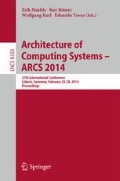Abstract
Graphics Processing Units (GPUs) have a large and complex design space that needs to be explored in order to optimize the performance of future GPUs. Statistical techniques are useful tools to help computer architects to predict performance of complex processors. In this study, these methods are utilized to build an effective performance prediction model for a Fermi GPU. The design space of this GPU is more than 8 million points. In order to build an accurate model, we propose a two-tier algorithm which builds a multiple linear regression model from a small set of simulated data. In this algorithm the Plackett and Burman design is used to find the key parameters of the GPU, and further simulations are guided by a fractional factorial design for the most important parameters. The generated performance model is able to predict the performance of any other point in the design space with an average prediction error between 1% to 5% for different benchmark applications. This accuracy is achieved by only sampling between 0.0003% to 0.0015% of the full design space.
Access this chapter
Tax calculation will be finalised at checkout
Purchases are for personal use only
Preview
Unable to display preview. Download preview PDF.
References
Bakhoda, A., Yuan, G.G.L., Fung, W.W.W.L., Wong, H., Aamodt, T.M.: Analyzing CUDA workloads using a detailed GPU simulator. In: 2009 IEEE International Symposium on Performance Analysis of Systems and Software, ISPASS 2009, pp. 163–174. IEEE (April 2009)
Jia, W., Shaw, K.A., Martonosi, M.: Stargazer: Automated Regression-Based GPU Design Space Exploration. In: IEEE International Symposium on Performance Analysis of Systems and Software, ISPASS (2012)
Lee, B., Brooks, D.: Accurate and efficient regression modeling for microarchitectural performance and power prediction. In: Proceedings of the 12th International Conference on Architectural Support for Programming Languages and Operating Systems, vol. 40, pp. 185–194. ACM (October 2006)
Joseph, P., Vaswani, K., Thazhuthaveetil, M.: Construction and Use of Linear Regression Models for Processor Performance Analysis. In: The Twelfth International Symposium on High-Performance Computer Architecture, pp. 99–108. IEEE (2006)
Yi, J., Lilja, D., Hawkins, D.: Improving computer architecture simulation methodology by adding statistical rigor. IEEE Transactions on Computers 54(11), 1360–1373 (2005)
Jooya, A., Baniasadi, A., Dimopoulos, N.J.: Efficient design space exploration of GPGPU architectures. In: Caragiannis, I., Alexander, M., Badia, R.M., Cannataro, M., Costan, A., Danelutto, M., Desprez, F., Krammer, B., Sahuquillo, J., Scott, S.L., Weidendorfer, J. (eds.) Euro-Par Workshops 2012. LNCS, vol. 7640, pp. 518–527. Springer, Heidelberg (2013)
Plackett, R., Burman, J.: The Design of Optimum Multifactorial Experiments. Biometrika 33(4), 305–325 (1946)
Montgomery, D.C., Runger, G.C.: Applied Statistics and Probability for Engineers, 5th edn. John Wiley & Sons (2010)
NVIDA: Whitepaper NVIDIA’s Next Generation CUDA Compute Architecture: Fermi (2009)
Che, S., Boyer, M., Meng, J., Tarjan, D., Sheaffer, J.W., Lee, S.H., Skadron, K.: Rodinia: A benchmark suite for heterogeneous computing. In: 2009 IEEE International Symposium on Workload Characterization IISWC 2009(c), pp. 44–54 (2009)
Author information
Authors and Affiliations
Editor information
Editors and Affiliations
Rights and permissions
Copyright information
© 2014 Springer International Publishing Switzerland
About this paper
Cite this paper
Mirsoleimani, S.A., Karami, A., Khunjush, F. (2014). A Two-Tier Design Space Exploration Algorithm to Construct a GPU Performance Predictor. In: Maehle, E., Römer, K., Karl, W., Tovar, E. (eds) Architecture of Computing Systems – ARCS 2014. ARCS 2014. Lecture Notes in Computer Science, vol 8350. Springer, Cham. https://doi.org/10.1007/978-3-319-04891-8_12
Download citation
DOI: https://doi.org/10.1007/978-3-319-04891-8_12
Publisher Name: Springer, Cham
Print ISBN: 978-3-319-04890-1
Online ISBN: 978-3-319-04891-8
eBook Packages: Computer ScienceComputer Science (R0)

